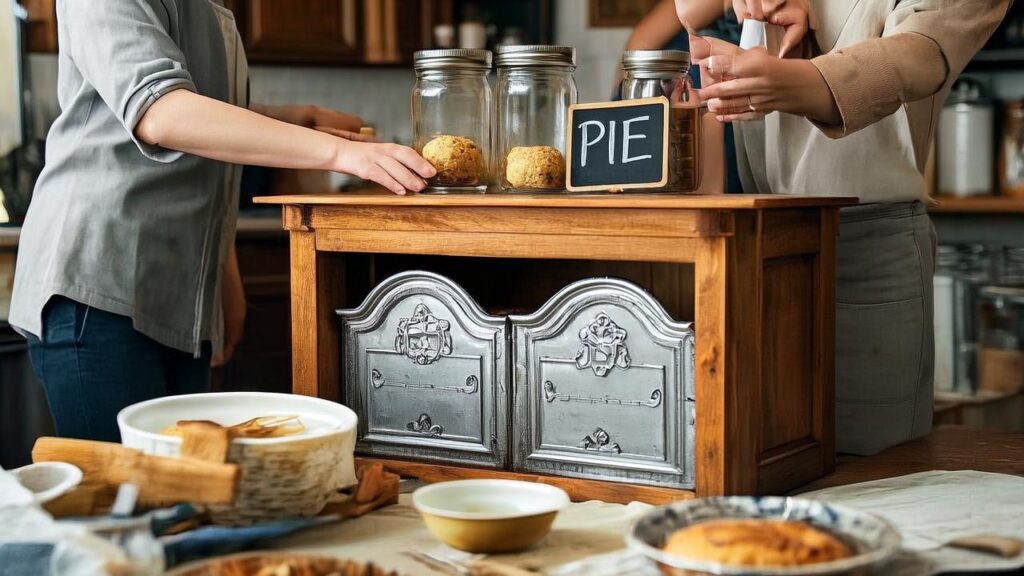In the world of vintage kitchenware, few items are as intriguing and nostalgic as the pie safe . Once a staple in farmhouse kitchens across America, the pie safe is more than just a decorative piece of furniture — it’s a functional relic of a bygone era. Whether you’re a collector, a history enthusiast, or someone looking to add rustic charm to your kitchen, understanding what a pie safe is and how it can be used today is both enlightening and practical.
At first glance, a pie safe might resemble a small cabinet or cupboard, but its purpose is unique. Designed to keep pies and other baked goods safe from pests and air exposure, it was an essential part of 19th and early 20th-century kitchens. Today, while modern refrigeration has made pie safes obsolete for their original purpose, they have found a new life as stylish storage units and decorative elements in contemporary homes.
This guide will walk you through the fascinating history of the pie safe, its design and function, how it evolved over time, and how it can be used in modern kitchens. We’ll also explore how to choose the right one for your home, tips for restoration and maintenance, and creative ways to style it in your space.
The Origins and Evolution of the Pie Safe
The pie safe traces its roots back to the 19th century, when food preservation was a daily challenge for American homemakers. Without refrigeration, keeping baked goods fresh and free from insects and animals was a constant concern. Enter the pie safe — a simple yet effective solution to this problem.
Originally crafted from wood and lined with tin panels punched with decorative patterns, these cabinets were designed with ventilation in mind. The punched tin allowed air to circulate, which helped prevent mold and spoilage, while the tight-fitting doors kept out pests like flies and mice. These tin panels, often featuring floral or geometric designs, also gave the pie safe a distinctive aesthetic that made it stand out in the kitchen.
During the 1800s, pie safes were commonly found in rural and small-town kitchens, especially in the Midwest and Southern United States. They were often handmade by local carpenters or tinsmiths, which means no two pie safes were exactly alike. The craftsmanship varied from region to region, with some featuring simple, utilitarian designs and others boasting intricate carvings and ornate tin work.
As the 20th century progressed and refrigeration became widespread, the need for pie safes diminished. By the mid-1900s, they were largely replaced by more modern storage solutions. However, their nostalgic appeal and charming design have ensured that pie safes remain popular among collectors and vintage decor enthusiasts.
Understanding the Design and Functionality of a Pie Safe
A typical pie safe is a freestanding cabinet, usually about 3 to 4 feet tall, with a hinged door or doors in the front. It often has a flat top, which can be used for serving or displaying items, and may include a few shelves inside for organizing pies, breads, and other baked goods.
The most distinctive feature of a pie safe is its tin lining. This tin was not only functional but also decorative. Tinsmiths would hand-punch intricate patterns into the metal, creating ventilation while adding visual appeal. These patterns could range from simple dots and lines to elaborate floral motifs and stars.
The wood used to construct pie safes varied depending on the region and the resources available. Oak, pine, and maple were common choices, and the cabinets were often finished with a simple varnish or paint. Some pie safes had feet or a base to elevate them slightly off the floor, helping to protect the wood from moisture and pests.
The doors of a pie safe were designed to be tight-fitting, sometimes with latches or simple hardware to keep them securely closed. In some cases, the doors were also lined with tin to enhance ventilation and durability.
While originally intended for pies, these cabinets were also used to store other perishable items such as bread, cakes, and even cheese. Their cool, dry environment made them ideal for short-term food storage in the days before refrigeration.
Modern Uses of a Pie Safe in Contemporary Kitchens
Though the pie safe no longer serves its original purpose due to modern refrigeration, it has found a new niche in today’s kitchens and homes. Many people now use pie safes as stylish storage solutions or decorative furniture pieces.
Here are some popular modern uses for a pie safe:
- Baking Ingredient Storage: Use it to store flour, sugar, baking powder, and other dry ingredients in jars. The pie safe’s vintage charm makes it a great centerpiece for organizing baking essentials.
- Kitchen Utensil Cabinet: Store mixing bowls, cookie sheets, and baking pans inside. The open shelves make it easy to access tools when baking.
- Coffee or Tea Station: Transform your pie safe into a cozy coffee or tea bar by placing a kettle, mugs, and a small electric kettle inside.
- Bar Cabinet: Convert it into a mini bar by storing wine glasses, spirits, and mixers. The enclosed design keeps everything neat and dust-free.
- Dining Room Buffet: Place it in the dining room to hold plates, linens, and serving dishes. The top surface can be used to display a centerpiece or serve food.
- Living Room Storage: Use it to store books, board games, or blankets. Its rustic look adds character to any living space.
- Bathroom Storage: Believe it or not, a pie safe can be a charming addition to a bathroom. Use it to store towels, toiletries, or even as a linen cabinet.
Because of its versatility, a pie safe can fit into almost any room in the house. Whether you’re going for a farmhouse, rustic, or eclectic decor style, this piece can blend in seamlessly.
How to Choose the Right Pie Safe for Your Home
When shopping for a pie safe , whether antique or modern reproduction, there are several factors to consider to ensure you get the right one for your space and needs.
Here’s a breakdown of what to look for:
When purchasing an antique pie safe, it’s a good idea to inspect it thoroughly. Check the hinges and latches to ensure they’re functional, and look for any signs of rot or insect damage in the wood. If the tin panels are rusted, they can often be replaced or restored.
For those who prefer a new piece without the hassle of restoration, many furniture retailers and artisan shops now offer pie safe replicas made with modern materials but designed to look vintage. These are often more durable and easier to maintain.
Restoring and Maintaining a Vintage Pie Safe
If you’ve acquired an antique pie safe , or plan to, restoration may be necessary to bring it back to its former glory. Here are some steps to follow for a successful restoration:
- Clean Thoroughly: Start by removing dust, dirt, and grime with a soft brush and mild soap. Avoid using water directly on the tin panels, as it can cause rust.
- Remove Old Paint or Finish: If the wood is in poor condition, stripping the old finish with a chemical stripper can help reveal the natural wood underneath.
- Repair Damaged Areas: Fill cracks or holes in the wood with wood filler. Replace any damaged tin panels if necessary.
- Sand and Refinish: Sand the wood to create a smooth surface. Apply a new finish such as paint, stain, or clear varnish.
- Restore Tin Panels: Clean the tin panels with a soft cloth. If rust is present, gently sand it off and apply a rust inhibitor before repainting.
- Reattach Hardware: Replace any missing or damaged hinges, latches, or handles with period-appropriate hardware.
- Protect Against Future Damage: Apply a sealant to protect the wood and tin from moisture and pests.
Regular maintenance of your pie safe includes dusting and avoiding excessive moisture. If you notice any signs of rust or wear, address them early to prevent further damage.
Styling Your Pie Safe in Different Interior Design Themes
One of the best things about a pie safe is its versatility in interior design. Depending on how you style it, a pie safe can complement a variety of decor themes:
- Farmhouse Style: Pair your pie safe with mason jars, vintage dishware, and woven baskets. Add a chalkboard label to the front for a cozy, personalized touch.
- Rustic Chic: Use it to display antique kitchen tools, copper pots, or dried herbs. The natural wood and tin details will enhance the rustic feel.
- Modern Farmhouse: Combine the pie safe with sleek appliances and clean lines. Paint it in a soft neutral shade like cream or gray for a fresh twist.
- Industrial Decor: Choose a pie safe with dark wood and metal accents. Add Edison bulbs or black iron fixtures to enhance the industrial vibe.
- Coastal or Cottage: Paint the pie safe in a light blue or white shade. Add seashells, glass bottles, and nautical-themed decor for a beachy feel.
- Eclectic Mix: Don’t be afraid to mix and match styles. A pie safe can stand out beautifully in a room filled with bold colors and unique furniture pieces.
The top surface of the pie safe can be used for displaying a vintage clock, a potted plant, or a collection of cookbooks. Inside, use baskets or bins to keep items organized yet visually appealing.
Final Thoughts: Why a Pie Safe Still Matters Today
In a world dominated by sleek, modern appliances and minimalist design, the pie safe stands out as a reminder of a simpler, more thoughtful time. It represents the ingenuity of early American homemakers who had to rely on creativity and craftsmanship to solve everyday problems.
Whether you’re drawn to its history, functionality, or aesthetic appeal, a pie safe is more than just a piece of furniture — it’s a conversation starter, a functional storage solution, and a beautiful addition to any home. Whether you find an antique treasure or opt for a modern reproduction, a pie safe can bring warmth, character, and a touch of nostalgia to your space.
So, if you’re looking to add a unique and timeless piece to your kitchen or home decor, consider the pie safe. It’s a small cabinet with a big story — and it might just become your favorite piece of furniture.
Summary Table: Pie Safe Overview
In conclusion, the pie safe is more than a relic of the past — it’s a versatile and stylish piece that continues to capture the hearts of homeowners and decorators alike. Whether you’re a collector, a baker, or simply someone who appreciates vintage charm, a pie safe is a worthwhile addition to any home.
Does this article help you? Explore our website to find more helpful and fun stories that could help







